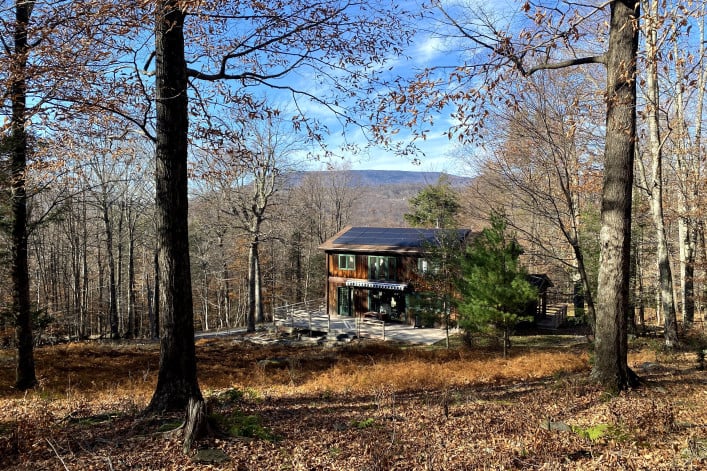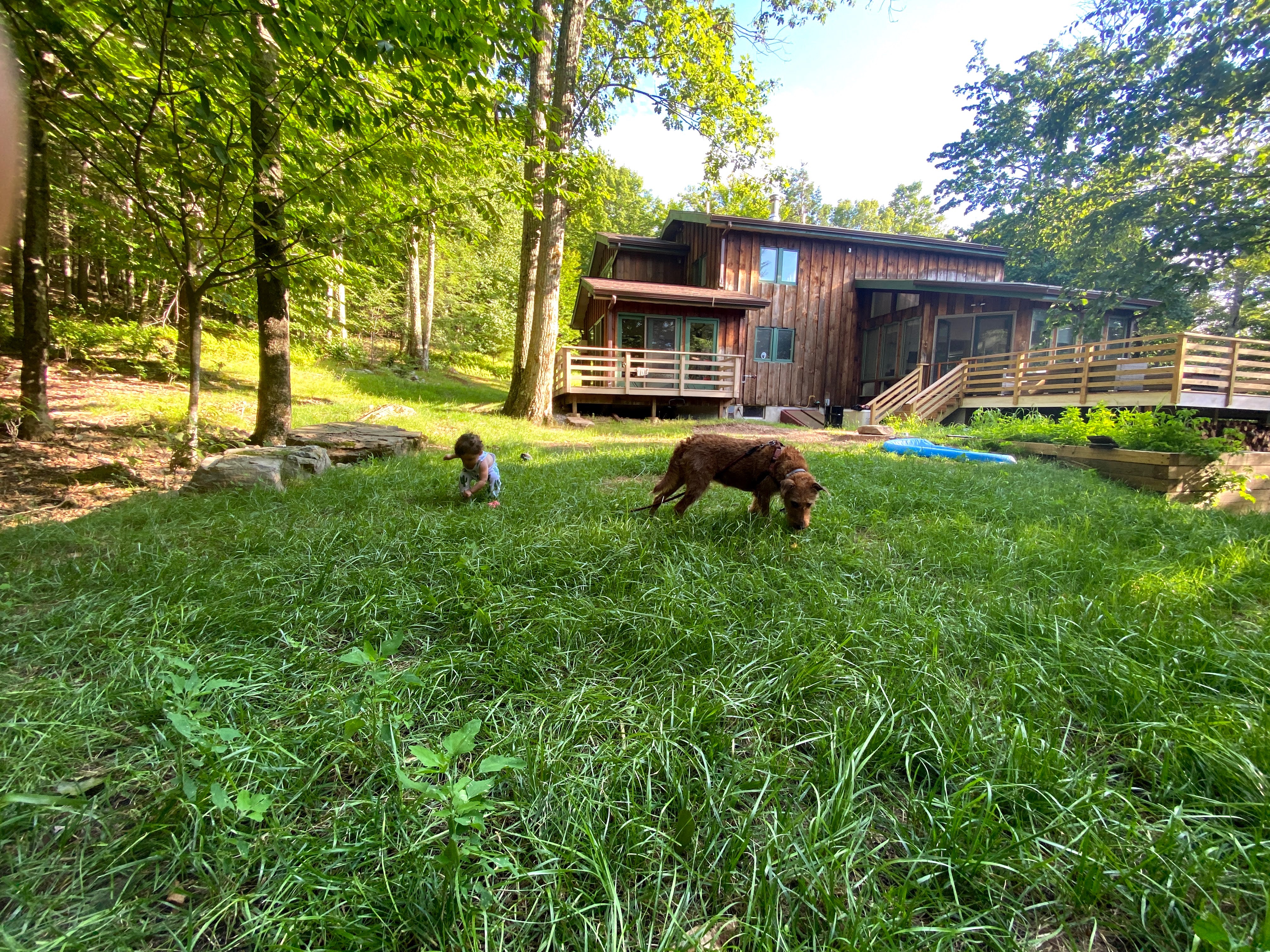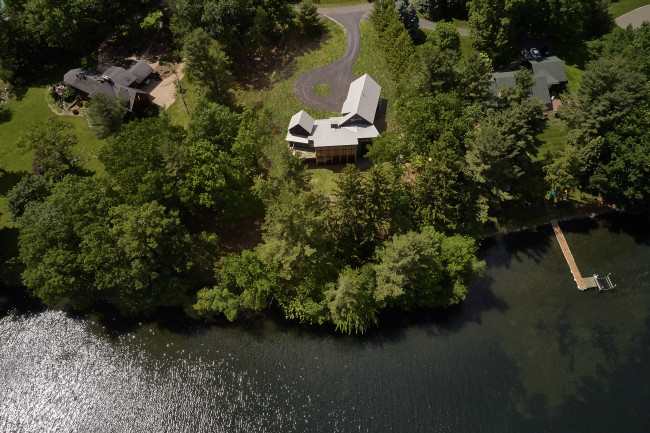Want to switch from fossil fuel to geothermal to heat your house? Here's what it will cost

For their weekend home in Bearsville, NY, owners installed a geothermal heat pump system from Dandelion Energy that's powered in part by solar energy.
Sree Kant
Many eco-minded New Yorkers are looking to move away from fossil fuels to heat their houses and reduce their carbon footprint. The move comes with health benefits when you consider the evidence that natural gas contributes to poor indoor air quality (like when cooking on a gas stove). Plus there are safety considerations—breathing fumes from gas appliances and oil furnaces is a leading cause of carbon monoxide poisoning in the home.
The most viable and effective option is the use of geothermal heat pumps (GHPs), also known as ground-source heat pumps, which effectively move heat from the earth, where it's a constant 50 degrees, into your home during the winter and into the cooler ground in the summer. "So you can harvest this renewable energy right under your yard," says Kathy Hunnan, founder of Dandelion Energy, a geothermal company that services the area spanning southern Westchester County up to Albany.
Take the example of Brooklyn residents Sree Kant and his wife Annie Duflo who purchased a home in Bearsville, NY, a few years ago. Besides wanting a weekend getaway, the couple is dedicated to being proactive about fighting climate change by embracing renewable energy and being intentional in their personal energy use—a commitment that strengthened when they decamped here when their daughter was born and again during the pandemic.
"Part of living in the mountains and among nature is having a sustainable home and we had already invested in solar panels so the next logical step was to stop heating the house by propane," he says. The house's old furnace was also inefficient and produced a lot of waste. Kant began looking at geothermal upon the advice of a friend and liked the "plug-and-play" Dandelion Energy model. "It made the most sense of all the companies we considered and seemed to have the most standardized offerings at a price point that fit our budget," he says.
Despite using technology that's been around for some 50 years, geothermal energy has only recently become more widely known. One reason: It has been notoriously and prohibitively expensive. But that's all changing now. Dandelion Energy, for example, offers four different models at a much more affordable price point (more on pricing below). It is also credited with creating incentives that shave a significant portion off the initial cost through its partnership with Con Edison.
"We were looking to provide ways for people to reliably and affordably heat their homes and switch from fossil fuels, and Dandelion Energy won the RFP for our Smart Solutions program for non-pipeline alternatives in Westchester County," says Mark Brescia, a program manager at Con Edison. Now those incentives are available from other utility companies across the state. He credits Dandelion Energy as creating a replicable, scalable model that's helping push prices down.
Installation is still costly (think five figures instead of six), but studies by the U.S. Department of Energy suggest a geothermal system will pay for itself within 10 years in energy savings—cutting your heating and cooling bills by as much as 65 percent. And you'll be reducing your carbon footprint in a big way, as geothermal systems run on electricity and do not emit any greenhouse gases into the environment.
Read on to learn how geothermal energy works, what it will cost, and how much you stand to save over time.
How does it work?
Geothermal systems circulate water through a series of connected pipes (called a ground loop) that are buried underground. A heat pump located inside the building removes heat from the water and transfers it to the building during winter and to the surrounding soil in summer. Then ductwork (like for conventional HVAC forced-air systems) distributes the warm or cool air from the heat pump throughout the home. In this way, GHPs can replace your existing heating and cooling system—and in many cases your hot-water mechanism—in one fell swoop.
Installation is usually completed in three stages:
Ground-loop installation involves some fairly hefty machinery to drill down into your yard and lay the pipes. Next the ground loop is connected to your home. Finally the actual heat-pump mechanism goes where your furnace now resides (your contractor will remove that as well) and is wired to your existing ductwork. If you don't have the requisite ductwork or it needs updating, that's going to be an additional step. (And Dandelion Energy does not service homes that have radiant baseboard heating only.) Each of these steps can take a few days or weeks depending on your specific site and the complexity of the project.
Once everything is in place, the system is invisible and you can't tell by looking at the house. "You no longer need outside compressors, which people find to be eyesores and also noisy," Hunnan says.

What does it cost to switch to geothermal energy?
Just a few years ago it could cost you upwards of $200,000 to do the necessary digging and infrastructure work to connect geothermal system to your existing heating and cooling network.
But now you can expect to pay more in the realm of $30,000 to $50,000—the bigger the home, the more it will cost. And you can take advantage of state and federal incentives to help ease the switch to geothermal, potentially saving you tens of thousands of dollars.
Under the New York State Clean Heat Program, part of New York State Energy Research and Development Authority (NYSERDA), each of the six utility companies offer its own unique incentives (as described on their website).
According to the Con Edison website, you can get up to $2,850 per 10,000 Btu/h of heating capacity off a home geothermal system—up to 300,000 Btu/h total, with $12,000 being the average. Plus you can get an additional $150 if you install a something called a desuperheater to supplement your existing water heater, or $1,000 for a ground-source, heat-pump water heater.
Kant qualified for a similar incentive through Central Hudson Utility. (The example on its website estimates that a 2,500 square foot house with a heat load of 62,500 Btu/h could qualify for up to a $10,000 incentive.)
On top of all that, the federal Investment Tax Credit allows you to write 26 percent off the price in 2020 and 22 percent in 2021. This can potentially save you thousands more.
If you can't cough up all the cash upfront, you can finance over time with zero down.
Hunnan says about half her customers opt to finance and that after incentives, the price of a Dandelion Energy system is $19,000 to $24,000 for an average-sized home of 2,500 square feet or less.
What about my electrical bills?
Although you will necessarily pay more for electricity after converting to geothermal, you will no longer have to pay for fossil fuels. Let's say you usually spend $3,000 to heat your home on oil each year. Even if you pay $1,000 more per year to your utility, you are still saving $2,000 on oil or gas.
Plus according to Brescia, the efficiency gains are phenomenal: For every unit of energy you put in you get 0.8 units of energy out with oil compared to three to four times the amount of heat out with geothermal. "That's how it becomes cost-effective and affordable," he says.
This is even true despite electricity being expensive in relation to the low cost of fossil fuel—and the savings will go up as the price of oil increases.
You'll also have much less in the way of maintenance and wear and tear, unlike with boilers which require routine cleaning and changing filters and have an average life span of 10 to 15 years. The internal geothermal equipment is purported to last 25 years, the in-ground loops 50 years or more.
"When we did the math it seemed like a no-brainer," Kant says, especially since at least some of the electricity is being generated through solar energy.
Indeed, by pairing geothermal with enough solar so you are generating your own electricity to heat and cool your home means you could end up at net-zero. (It's worth noting that Con Ed is the #2 solar generator in the country.)
What if I live in New York City?
Brescia says geothermal is a key component of switching to a whole electric home, and not just in the suburbs or rural locations.
"It's an amazing technology for new construction when you are able to put the ground loops right underneath the foundation as a way to maximize your lot," he says.
You can also retrofit existing coops and condos so long as there is a courtyard or other outdoor area.
Brownstones are often off-limits, because you need access and space to drill and install the ground loops. That said, if you are doing a major rehab, it might be worth looking into.
Or you could consider other types of heat pumps, such as variable refrigerant flow (VRF) or ductless air-source heat pumps (aka mini splits). "Both are high-efficiency premium technologies with good rebates from Con Ed to make them more cost-effective," Brescia says.
(Read more about the pros and cons of installing ductless systems in your NYC brownstone in this Brick Underground post.)
No matter where you live, there's a heat-pump solution to let you bid farewell to fossil fuels.
Are there any steps to take before converting?
Start by checking your utility company's website for information on converting to geothermal energy. There you can find specific incentives and also participating contractors, who can either evaluate your home virtually or in an-person consultation.
Brescia always advises that you do weatherization work before converting. Then you can have a smaller, more appropriately sized geothermal system.
You'll get the most bang for your buck by insulating and air-sealing at the attic level (warm air rises), whether that is your actual roof in a brownstone or a traditional attic. Air-sealing the basement, typically by spraying foam into the rim joists where the wood meets the concrete, is the next-best thing.
Windows are nice to upgrade but he recommends doing so only after investing in solar and geothermal. "Windows are expensive and won't pay off as much in terms of energy cost savings," he says.
Just be sure that you do this in conjunction with converting to geothermal; otherwise you may be trapping in even more of the combustible gases from your furnace in the meantime.
And if you haven't already, consider switching to solar energy to power your new clean heating and cooling system.
You Might Also Like


























